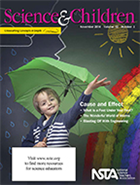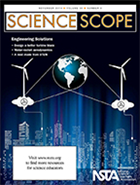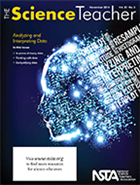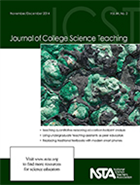NSTA’s K–College Science Education Journals: November 2014 Issues Online
By Lauren Jonas, NSTA Assistant Executive Director
Posted on 2014-11-14
Cause and effect, solutions to problems, analyzing and interpreting data, and quantitative reasoning… these are the subjects science teachers are writing about in this month’s K-College journals from NSTA. The November issues are online, in members’ mailboxes, and ready to inspire teachers!
Science and Children
 No matter the age at which you introduce cause and effect, it must be consciously developed and repeated frequently. The resources in this issue of S&C will help your students extend their understanding of this essential crosscutting concept.
No matter the age at which you introduce cause and effect, it must be consciously developed and repeated frequently. The resources in this issue of S&C will help your students extend their understanding of this essential crosscutting concept.
Featured articles (please note, only those marked “free” are available to nonmembers without a fee):
- Free – Editor’s Note: Cause and Effect
- Real-World Units in the Conceptual Age
- STEM in a Hair Accessory
- Free – The Wonderful World of Worms
- What Is a Foot Under Your Feet?
- Full Table of Contents
Science Scope
 Science and engineering can offer solutions to many of today’s most challenging problems. In this issue, we explore a number of STEM-based activities that will help turn your students into the problem solvers of tomorrow.
Science and engineering can offer solutions to many of today’s most challenging problems. In this issue, we explore a number of STEM-based activities that will help turn your students into the problem solvers of tomorrow.
Featured articles (please note, only those marked “free” are available to nonmembers without a fee):
- Construct, Critique, and Connect: Engineering as a Vehicle to Learn Science
- Designing Earthquake-Resistant Structures: Integrating Science and Engineering Practices
- Free – Editor’s Roundtable: EQuIP—A Tool to Help Keep the NGSS on Course
- Free – Engineering Design and EFFECTs: A Water Filtration Example
- Redesigning the Water Rocket: An Engineering-Design Cycle for Integrating Science and Engineering Practices and Nature of Science Learning
- Saving Pelicans: A STEM Integration Unit
- The Justin Time Challenge
- Full Table of Contents
The Science Teacher
 Our world is awash in a sea of data. We encounter more data on a daily basis than ever before, conveying information about weather, health, politics, finance, and science. Data arrives via sensors, social media, digital photos, weather stations, and many other sources. As our ability to store and share data increases exponentially, our students must develop the skills and habits of mind necessary to analyze and interpret information. The Next Generation Science Standards recognize Analyzing and Interpreting Data as one of the eight essential practices of science and engineering. This issue offers ideas for including this important practice in your own teaching.
Our world is awash in a sea of data. We encounter more data on a daily basis than ever before, conveying information about weather, health, politics, finance, and science. Data arrives via sensors, social media, digital photos, weather stations, and many other sources. As our ability to store and share data increases exponentially, our students must develop the skills and habits of mind necessary to analyze and interpret information. The Next Generation Science Standards recognize Analyzing and Interpreting Data as one of the eight essential practices of science and engineering. This issue offers ideas for including this important practice in your own teaching.
Featured articles (please note, only those marked “free” are available to nonmembers without a fee):
- Demystifying Data
- Free – Editor’s Corner: Analyzing and Interpreting Data
- Free – In Praise of Messy Data
- Reflecting on Data
- The Graph Choice Chart
- The Green Room: The Deadliest Infectious Diseases
- Thinking With Data
- Full Table of Contents
Journal of College Science Teaching
 Read about a laboratory exercise (the calculation of an individual’s own carbon footprint) designed to teach quantitative reasoning in the context of authentic problems that are relevant to students’ lives. Find out how one group of authors made their undergraduate atmospheric science classes more student centered and collaborative through the implementation of high-altitude balloon research. Don’t miss the article about an ecology course in which textbooks were eliminated and students were allowed to learn science using their cell phones in place of textbooks. Find all this and more in this month’s issue of JCST.
Read about a laboratory exercise (the calculation of an individual’s own carbon footprint) designed to teach quantitative reasoning in the context of authentic problems that are relevant to students’ lives. Find out how one group of authors made their undergraduate atmospheric science classes more student centered and collaborative through the implementation of high-altitude balloon research. Don’t miss the article about an ecology course in which textbooks were eliminated and students were allowed to learn science using their cell phones in place of textbooks. Find all this and more in this month’s issue of JCST.
Featured articles (please note, only those marked “free” are available to nonmembers without a fee):
- Active Learning in the Atmospheric Science Classroom and Beyond Through High-Altitude Ballooning
- Eliminating the Textbook: Learning Science With Cell Phones
- Point of View: Why Students Should Listen
- Research and Teaching: Midterm and First-Exam Grades Predict Final Grades in Biology Courses
- Research and Teaching: Statistics Across the Curriculum Using an Iterative, Interactive Approach in an Inquiry-Based Lab Sequence
- Research and Teaching: Undergraduate Science Learners Show Comparable Outcomes Whether Taught by Undergraduate or Graduate Teaching Assistants
- Free – Teaching Quantitative Reasoning for Nonscience Majors Through Carbon Footprint Analysis
- Too Long to Read: Assessing the Motivation Behind Graduate Student Attendance in Reading Groups
- Using Collaboration Between English and Biology to Teach Scientific Writing and Communication
- Full Table of Contents
Get these journals in your mailbox as well as your inbox—become an NSTA member!
The mission of NSTA is to promote excellence and innovation in science teaching and learning for all.
Follow NSTA
| |
|
|
|
Disclaimer: The views expressed in this blog post are those of the author(s) and do not necessarily reflect the official position of the National Science Teaching Association (NSTA).


